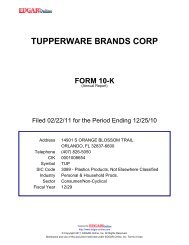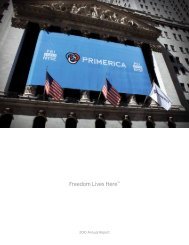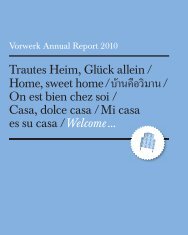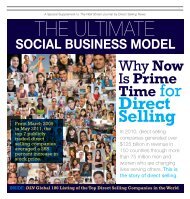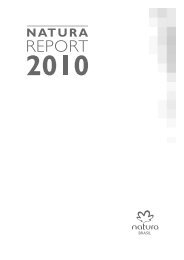Nu Skin 2010 Annual Report - Direct Selling News
Nu Skin 2010 Annual Report - Direct Selling News
Nu Skin 2010 Annual Report - Direct Selling News
Create successful ePaper yourself
Turn your PDF publications into a flip-book with our unique Google optimized e-Paper software.
NU SKIN ENTERPRISES, INC.<br />
Notes to Consolidated Financial Statements<br />
or most advantageous market for the asset or liability in an orderly transaction<br />
between market participants at the measurement date. On a<br />
quarterly basis, the Company measures at fair value certain financial<br />
assets, including cash equivalents and available-for-sale securities. Accounting<br />
standards specify a hierarchy of valuation techniques based<br />
on whether the inputs to those valuation techniques are observable or<br />
unobservable. Observable inputs reflect data obtained from independent<br />
sources, while unobservable inputs reflect the Company’s market<br />
assumptions. These two types of inputs have created the following fairvalue<br />
hierarchy:<br />
• Level 1—quoted prices in active markets for identical assets or<br />
liabilities;<br />
• Level 2—inputs, other than the quoted prices in active markets,<br />
that are observable either directly or indirectly;<br />
• Level 3—unobservable inputs based on the Company’s own<br />
assumptions.<br />
Accounting standards permit companies, at their option, to<br />
choose to measure many financial instruments and certain other<br />
items at fair value. The Company has elected to not fair value existing<br />
eligible items<br />
STOCK-BASED COMPENSATION<br />
All share-based payments, including grants of stock options and<br />
restricted stock units, are required to be recognized in our financial<br />
statements based upon their respective grant date fair values. The<br />
Black-Scholes option pricing model is used to estimate the fair value<br />
of stock options. The determination of the fair value of stock options<br />
is affected by our stock price and a number of assumptions, including<br />
expected volatility, expected life, risk-free interest rate and expected<br />
dividends. We use historical volatility as the expected volatility assumption<br />
required in the Black-Scholes model. The expected life of<br />
the stock options is based on historical data trended into the future.<br />
The risk-free interest rate assumption is based on observed interest<br />
rates appropriate for the expected terms of our stock options. The<br />
fair value of our restricted stock units is based on the closing market<br />
price of our stock on the date of grant less our expected dividend<br />
yield. We recognize stock-based compensation net of any estimated<br />
forfeitures on a straight-line basis over the requisite service period of<br />
the award.<br />
The total compensation expense related to equity compensation<br />
plans was approximately $7.3 million, $10.0 million and $10.8 million<br />
for the years ended December 31, 2008, 2009 and <strong>2010</strong>. For the<br />
years ended December 31, 2008, 2009 and <strong>2010</strong>, all stock-based<br />
compensation expense was recorded within general and administrative<br />
expenses.<br />
REPORTING COMPREHENSIVE INCOME<br />
Comprehensive income is defined as the change in equity of a<br />
business enterprise during a period from transactions and other<br />
events and circumstances from non-owner sources, and it includes all<br />
changes in equity during a period except those resulting from investments<br />
by owners and distributions to owners.<br />
ACCOUNTING FOR DERIVATIVE INSTRUMENTS AND<br />
HEDGING ACTIVITIES<br />
The Company recognizes all derivatives as either assets or liabilities,<br />
with the instruments measured at fair value.<br />
The Company’s Subsidiaries enter into significant transactions<br />
with each other and third parties that may not be denominated in the<br />
respective Subsidiaries’ functional currencies. The Company regularly<br />
monitors its foreign currency risks and seeks to reduce its exposure to<br />
fluctuations in foreign exchange rates using foreign currency exchange<br />
contracts and through certain intercompany loans of foreign currency.<br />
The Company hedges its exposure to future cash flows from<br />
forecasted transactions over a maximum period of 12 months. Hedge<br />
effectiveness is assessed at inception and throughout the life of the<br />
hedge to ensure the hedge qualifies for hedge accounting treatment.<br />
Changes in fair value associated with hedge ineffectiveness, if any, are<br />
recorded in the results of operations currently. In the event that an anticipated<br />
transaction is no longer likely to occur, the Company recognizes<br />
the change in fair value of the derivative in its results of operations<br />
currently.<br />
Changes in the fair value of derivatives are recorded in current<br />
earnings or accumulated other comprehensive loss, depending on the<br />
intended use of the derivative and its resulting designation. The gains<br />
and losses in accumulated other comprehensive loss stemming from<br />
these derivatives will be reclassified into earnings in the period during<br />
which the hedged forecasted transaction affects earnings. The fair<br />
value of the receivable and payable amounts related to these unrealized<br />
gains and losses is classified as other current assets and liabilities.<br />
The Company does not use such derivative financial instruments for<br />
trading or speculative purposes. Gains and losses on certain intercompany<br />
loans of foreign currency are recorded as other income and expense<br />
in the consolidated statements of income.<br />
58



